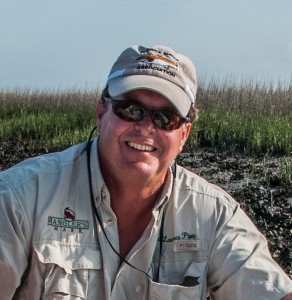Submitted by Lawrence Piper
Photos by Elizabeth Wilkes
www.elizabethwilkesphotography.com
December 7, 2014 9:28 a.m.

When I mention to visitors that I offer fly fishing on my Amelia Island fishing charters they often reply, “where in the world would you fly fish in north Florida?” A lot of people equate fly fishing with the trout streams up north or out west but here in the North Florida area we have excellent fishing and taking those fish on a fly is a challenging option. Flood tide fishing for tailing Redfish, low tide fishing for backing Redfish, Seatrout fishing at night under the docks, and bream and bass fishing in our creeks, ponds and lakes are just a few of the great fly fishing opportunities that we have.
But before you step out into the marsh with the long rod you will need to learn to cast! Casting a fly with a fly rod is unlike any other fishing you’ve ever done. For one, you will need to incorporate a back cast along with the forward cast, which takes some getting used to. With spin or bait casting there is usually a heavy enough weight in your tackle that when you make your cast it drags the light fishing line with it. But with fly fishing, the fly is usually so light you will need to use your rod to form loops in a heavier fly line to carry the fly and leader along with it, thus making the cast.
The Federation of Fly Fishers is an international organization dedicated to the sport of fly fishing, fly casting, fly tying and conservation. Years ago dedicated fly casters with the FFF set forth 5 principles for a good fly cast. They determined that many casters would have different styles of casting but in order to make a good cast they all would incorporate the same 5 principles. Just like any other sport, practice will make you a better fly caster. There are many fields and parks on Amelia Island where you can practice your casting. Use a piece of yarn as your fly and practice you casting on grass so that when you get out on the water you’ll be ready to catch some fish!
Principle Number 1:
 Keep slack out of your fly line. As you accelerate your rod the weight of the fly line is going to put a bend in the rod causing it to load with energy. When you stop your cast that rod is going to unbend or unload and propel the line forward on a forward cast and backward on a back cast. If slack is introduced then the rod will not get its maximum load and the cast will be poor.
Keep slack out of your fly line. As you accelerate your rod the weight of the fly line is going to put a bend in the rod causing it to load with energy. When you stop your cast that rod is going to unbend or unload and propel the line forward on a forward cast and backward on a back cast. If slack is introduced then the rod will not get its maximum load and the cast will be poor.
One of the most common errors is starting the back cast when the rod is held too high off of the water – slack is between the rod tip and the water. Always get any slack out between the rod tip and the water. You can do this by holding your rod tip down at the water and stripping in any excess slack. Or you can perform a roll cast to get the line straightened out. Then begin your back cast with the rod tip down at the water and you will see that the rod immediately begins to load as you accelerate back. Another common error that introduces slack is called Creep. After making the stop on the back cast, some casters will “creep” forward before the fly line has a chance to fully unroll, then they will begin their actual forward cast. This introduces slack line in the cast and again, the rod will not get its maximum load and the cast will be poor.
If you feel like you are creeping forward you may want to consciously insert a technique called Drift. Watch your back cast and after you have made your stop, “drift” the rod hand back even further until the fly line unrolls. You should begin to feel the rod getting heavier which indicates a good load. Now you’re ready to Accelerate on your forward cast… which we’ll cover in next week’s principle!
Capt. Lawrence Piper is a back country fishing guide at Amelia Island and a FFF Certified Fly Casting Instructor. Capt. Piper can be reached at www.TheAnglersMark.com 904-557-1027 [email protected]
